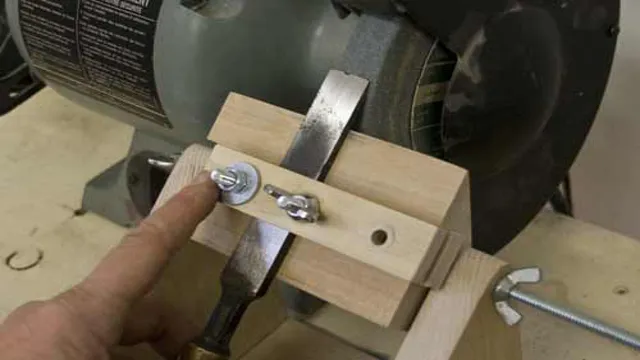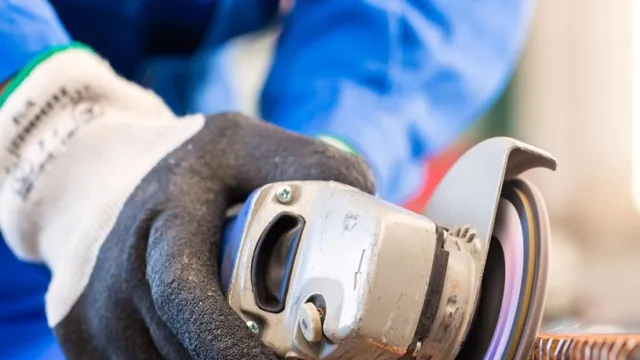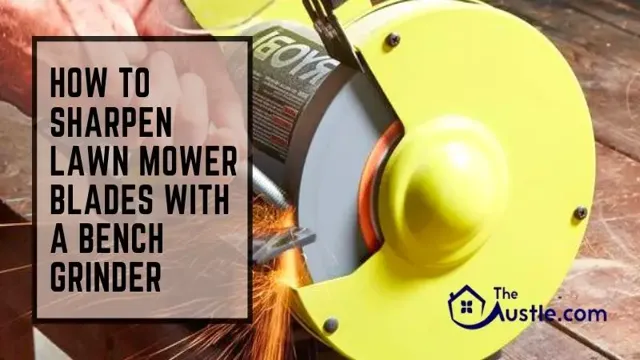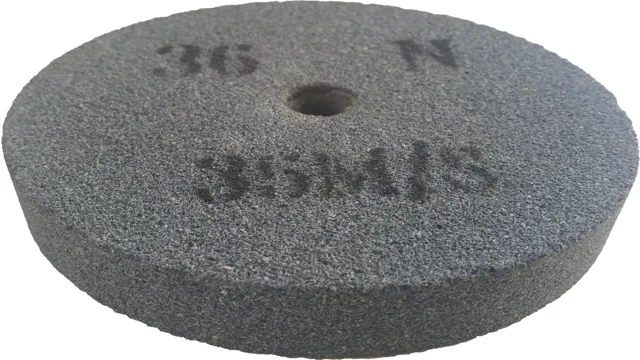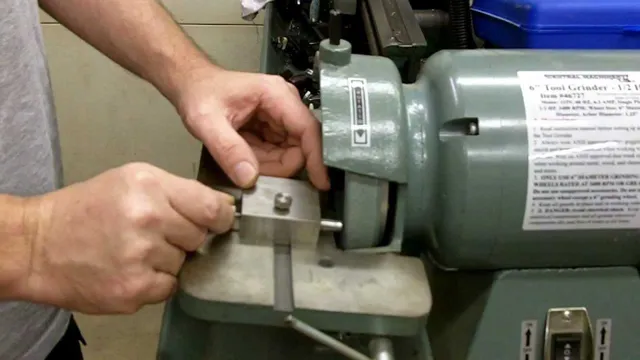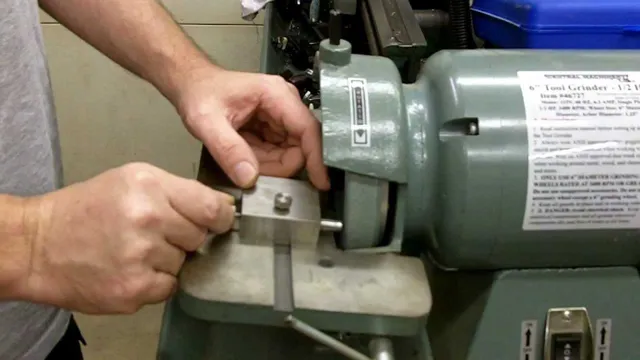Can You Sharpen Knives with a Bench Grinder? A Beginner’s Guide to Sharpening Knives with a Bench Grinder
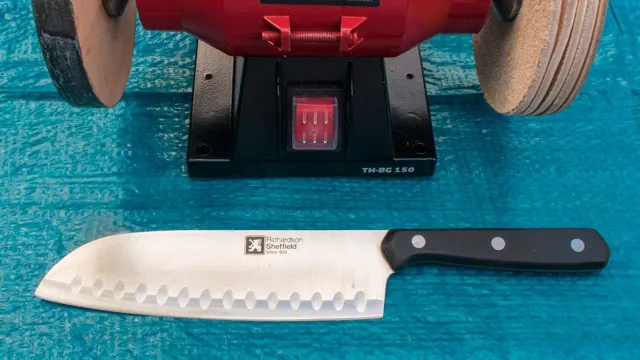
Sharpening knives is a necessary skill for any cook or kitchen enthusiast. And, while there are different methods for this, using a bench grinder is one of the most popular options. But, before delving into the process, it’s essential to know what you need to know and what considerations you need to make.
Sharpening knives with a bench grinder can be easy or challenging, depending on your experience level and tools. That’s why in this blog, we’ll discuss everything you need to know before sharpening your knives with a bench grinder. From the benefits of using a bench grinder, the steps to follow, to the mistakes to avoid, we’ll provide all the information to equip you with the knowledge and skills to sharpen your knives with ease.
So, let’s dive in and sharpen your knives like a pro!
What is a Bench Grinder?
If you’re someone who loves cooking and uses a variety of knives in the kitchen, you’ve probably faced the issue of dull blades. A bench grinder is a tool that can be used to sharpen knives, but it isn’t the best option. Bench grinders are typically used for sharpening metal tools, and using them on knives can be quite risky.
It’s easy to damage the knife’s edge or overheat it, which can lead to poor performance or even breakage. If you’re looking to sharpen your knives, it’s best to invest in a good-quality knife sharpener or take them to a professional. While a bench grinder can technically be used for sharpening knives, it’s certainly not recommended for the best results.
Therefore, it’s better not to take the risk of ruining your knives and to use purpose-built equipment instead.
Explanation of a bench grinder and how it works.
A bench grinder is a tool commonly used in workshops for sharpening tools and shaping metal objects. It consists of two rotating wheels, one being coarse and the other being fine, that spin at high speeds. The wheels are made of abrasive material and are used for different purposes.
The coarse wheel is used for removing larger amounts of material quickly, whereas the fine wheel is used for honing and sharpening. Bench grinders can also be equipped with attachments such as wire brushes or polishing pads to give a different finish on the workpiece. The grinding wheels can be adjusted for different angles and positions to make the process more precise.
Operating a bench grinder requires some training and safety measures since it can be a dangerous tool if used improperly. It is important to always wear eye protection and use the grinder’s tool rests to maintain a safe distance from the wheels.
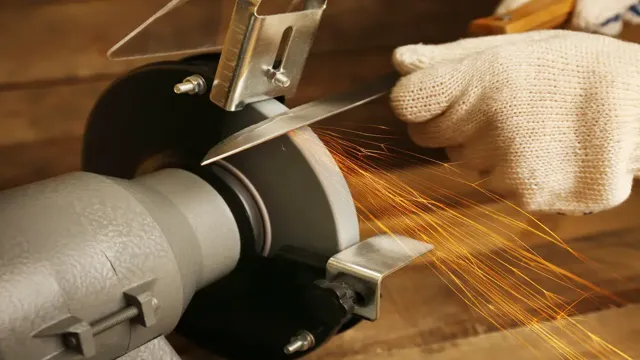
Can a Bench Grinder be Used to Sharpen Knives?
Yes, a bench grinder can certainly be used to sharpen knives, but it is important to approach this task with caution and care. A bench grinder is a powerful machine that can quickly grind away metal, so it is essential to follow some basic safety measures. Firstly, ensure that the knife blade is properly secured in a jig or clamp, so it doesn’t move or spin unexpectedly during the sharpening process.
Next, adjust the grinder’s tool rest to maintain a consistent angle of about 20-25 degrees to match the existing bevel angle of the blade. Move the knife blade slowly across the spinning wheel, using light pressure and smooth strokes to avoid overheating or unnecessarily grinding away too much metal. Remember to frequently check the blade’s angle and progress to ensure the correct sharpness level is achieved.
So, with the right precautions, it’s possible to use a bench grinder to sharpen knives effectively.
Yes or No? Advantages and disadvantages of using a bench grinder for knife sharpening.
A bench grinder can be used to sharpen knives, but it has its advantages and disadvantages. The main advantage of using a bench grinder is that it can quickly remove metal and reshape the blade. However, this can also be a disadvantage as it can remove too much material and damage the blade if not done properly.
Additionally, the heat generated by the grinder can also damage the blade, causing it to lose its temper and become brittle. Another disadvantage of using a bench grinder is that it requires the user to have a steady hand and careful technique. Any mistake or slip can cause the blade to become uneven or even ruined.
Furthermore, the grinder’s abrasive wheels can leave deep scratches on the blade, which can affect its cutting ability and cause it to rust over time. In conclusion, a bench grinder can be an effective tool for knife sharpening, but it is not recommended for beginners or those without proper training and technique. It is recommended to use a sharpening stone or honing rod for novice sharpeners.
However, if you have experience and are confident in your ability to use a bench grinder properly, it can be a quick and efficient way to sharpen your knives.
How to Sharpen Knives with a Bench Grinder?
Yes, you can definitely sharpen knives with a bench grinder. In fact, using a bench grinder to sharpen your knives is one of the most efficient and effective methods for maintaining a sharp edge on your blades. However, it is important to keep in mind that using a bench grinder can also be a bit tricky and requires some practice to perfect.
The first step is to ensure that the grinder is adjusted to the correct angle and that the blade is held securely in place. From there, the trick is to carefully guide the blade along the grinding wheel, taking care to maintain a consistent angle and applying firm pressure. It’s also important to go slow and avoid overheating the blade, as this can lead to dulling rather than sharpening.
With a little bit of patience and practice, sharpening your knives with a bench grinder can be a great way to keep your kitchen cutlery in top condition.
Step-by-step guide for sharpening knives on a bench grinder.
Sharpening knives on a bench grinder is a quick and easy way to get your blade back in tip-top condition. To start off, you’ll need to adjust the bench grinder’s tool rest to the correct angle for your blade (usually around 20-25 degrees). Then, turn on the grinder and gently place the blade against the wheel, being sure to maintain the correct angle.
Move the blade back and forth along the wheel, using light pressure. It’s important to check the blade frequently to ensure that no heat buildup is occurring, as this can damage the blade’s temper. Once you’ve ground down all the nicks and dings in the blade, switch to a finer grit wheel to polish the blade and give it a razor-sharp edge.
Remember to always wear protective gear, including eye and ear protection, and to keep your fingers away from the wheel. By following these simple steps, you’ll have a perfectly sharpened blade in no time.
Safety precautions when sharpening knives with a bench grinder.
When it comes to sharpening knives with a bench grinder, it is important to take the necessary safety precautions to prevent any accidents or injuries. First and foremost, always wear protective gear such as gloves and eye goggles to safeguard yourself from sparks and any flying debris. Next, ensure that the grinding wheel is securely fastened and aligned properly before turning on the grinder.
When sharpening the knife, use a light touch and avoid pressing too hard as this can damage the blade or cause it to overheat. Take breaks frequently and dunk the knife in cool water to prevent overheating and maintain its temper. It’s also important to keep the work area clean and organized to avoid any tripping hazards or accidental cuts.
By following these safety tips, you can sharpen your knives effectively and efficiently without compromising your safety.
Common Mistakes to Avoid
If you’re wondering whether you can sharpen knives with a bench grinder, the simple answer is yes. However, there are some common mistakes to avoid to ensure that your knives come out sharp and not ruined after using a bench grinder. Firstly, using too much pressure or grinding for too long can overheat the blade, causing it to lose its temper and become brittle.
Secondly, using the wrong wheel can cause damage to the blade and even create a beveled edge. It’s important to use a fine-grit wheel and to make sure it’s properly aligned with the blade’s bevel angle. Finally, if you’re not experienced with sharpening, it’s best to practice on old blades or seek guidance from a professional before attempting to sharpen your best knives with a bench grinder.
Overall, if you take the time to properly set up your grinder and approach the task with patience and care, a bench grinder can be a useful tool for sharpening your knives.
Important things to keep in mind to avoid damaging your knives.
To keep your knives in good condition, you must be aware of the common mistakes that can damage them. One of the most significant mistakes is using the wrong cutting surface. Avoid cutting on hard surfaces such as ceramic plates or granite countertops, as they can dull the blade.
Instead, opt for a soft cutting board made of wood or plastic. Another mistake is neglecting to clean and dry the knives after use. Leaving them wet can lead to rust and corrosion, which can ultimately damage the blade.
It’s also essential to store your knives correctly. Don’t just toss them in a drawer where they can bang against each other, as this can cause chips or nicks in the blade. Instead, use a knife block, magnetic strip, or blade guard to keep them safe and protected.
Remember, properly caring for your knives can extend their lifespan and ensure they perform their best when you need them.
Alternatives to a Bench Grinder
If you’re wondering whether you can sharpen knives with a bench grinder, the answer is yes, you can. However, there are also alternatives to a bench grinder that are worth considering. For example, you can use a sharpening stone, honing rod, or electric sharpener.
Sharpening stones provide a traditional method for sharpening knives by honing and removing metal from the blade. They come in different grits, so you can choose the appropriate one depending on the dullness of your knife. Honing rods are great for maintenance and upkeep in between sharpening sessions.
They straighten out the edge of the blade, giving it a razor-sharp finish. Electric sharpeners, on the other hand, use rotating wheels and abrasives to grind away at the blade. They are fast and efficient, but you have less control than with a sharpening stone or honing rod.
Ultimately, the method you choose depends on your preference and skill level. Whatever method you use, the key is to maintain a consistent angle and use only light pressure.
Explanation of other tools and methods for knife sharpening.
When it comes to knife sharpening, there are many alternatives to using a bench grinder. One popular option is using a whetstone or sharpening stone. This method involves running the blade back and forth over the stone at the appropriate angle, gradually sharpening the edge.
Another option is using a honing rod, also known as a sharpening steel. This tool is used to straighten out the blade’s edge, rather than removing any material. Lastly, there are also electric sharpeners which use diamond abrasive wheels to quickly sharpen the edge of knives.
It’s important to note that each of these methods has its strengths and weaknesses, and some are better suited for certain types of blades. Ultimately, the best method will depend on the type of knife you are sharpening and your personal preference.
Conclusion
In conclusion, while it is technically possible to sharpen knives with a bench grinder, it is not recommended for two main reasons: 1) bench grinders tend to remove too much metal from the blade, shortening its lifespan, and 2) the risk of ruining the knife’s temper and destroying its hardness. So, while you may be able to “sharpen” your knife on a bench grinder, it’s probably best to leave that task to a professional or invest in a proper sharpening tool.”
FAQs
What type of grinder is best for sharpening knives?
A bench grinder can be used for sharpening knives, but it is not necessarily the best option. A belt grinder or a sharpening stone may be more effective.
Is it safe to use a bench grinder to sharpen knives?
Yes, it is safe to use a bench grinder to sharpen knives as long as proper safety precautions are taken. This includes wearing eye and ear protection, using a steady hand, and keeping the grinding wheel properly adjusted.
Can I use a regular grinding wheel to sharpen knives?
A regular grinding wheel may be too rough for sharpening knives and could potentially damage the blade. It is recommended to use a fine-grit grinding wheel or a specialized sharpening wheel to avoid any unwanted damage.
How often should I sharpen my knives using a bench grinder?
The frequency of sharpening your knives depends on how often they are used. However, it is generally recommended to sharpen them every 2-3 months to maintain their sharpness.
What angle should I sharpen my knives at with a bench grinder?
The ideal angle to sharpen a knife with a bench grinder is between 20-25 degrees. It is important to maintain this angle consistently on both sides of the blade to achieve a razor-sharp edge.
How do I clean and maintain my bench grinder after sharpening my knives?
After sharpening your knives with a bench grinder, it is important to clean the machine thoroughly to prevent any buildup and maintain its longevity. Use a brush to remove any excess metal shavings and wipe it down with a clean cloth. Additionally, you should also regularly check the grinding wheel for any cracks or damage and adjust it if necessary.
Can a bench grinder be used to sharpen other tools besides knives?
Yes, a bench grinder can be used to sharpen various tools such as chisels, drill bits, and scissors. However, it is important to adjust the grinding wheel accordingly and use proper safety precautions.

